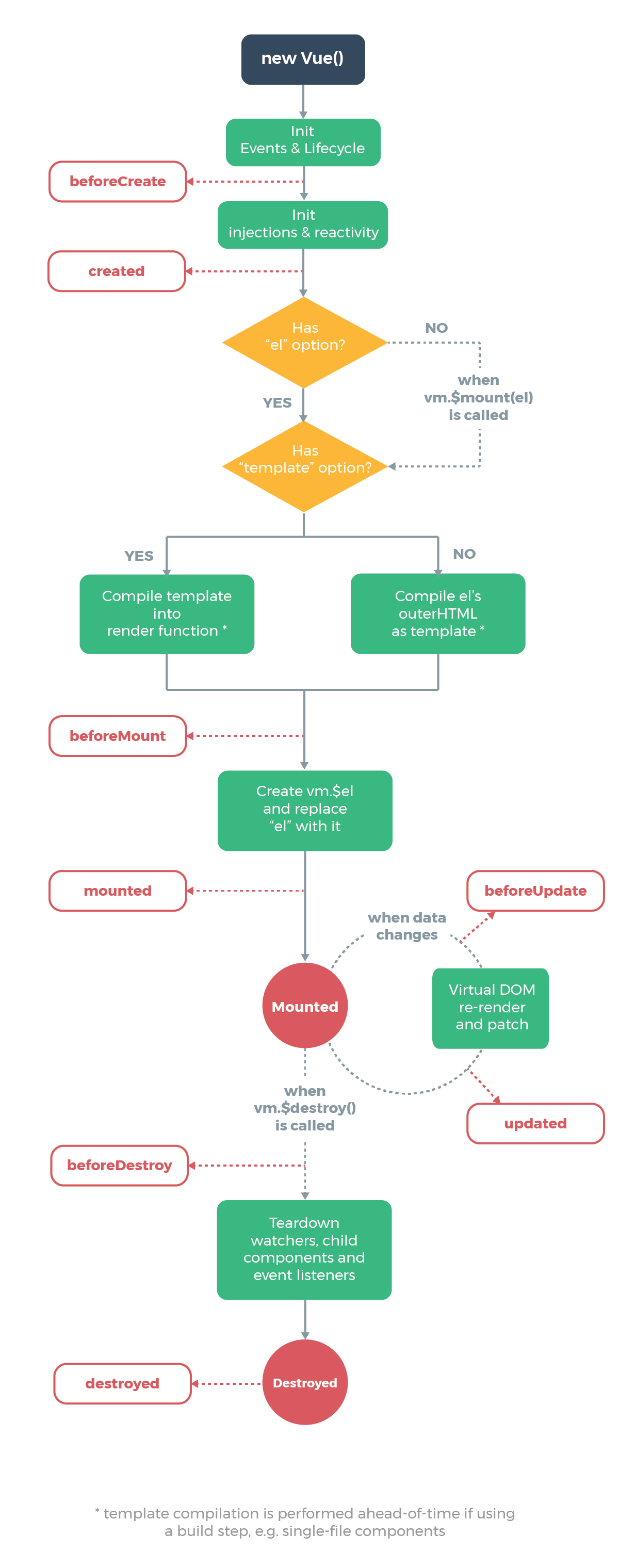# Vue 實體的生命週期
一個 Vue 實體有生老病死,而 Vue 實體會在各個生命階段提供鉤子事件( Hook Event )讓開發者可以在實體的不同階段做想要的處理,本文介紹各個 Hook 的叫用時機。
# 各階段的鉤子函式
官方製作了一張詳細的生命週期鉤子函式示意圖 (opens new window):

紅框白底的是各個鉤子函式的名稱,這些鉤子代表 Vue 實體的每個階段,分別的介紹如下:
beforeCreate: 實例初始化立即叫用,這時還未創建實例,所以任何 Vue 實體中的設定(例如:data)都還未配置。created: 完成創建實例,這時 Vue 實體中的配置除了$el外已全部配置,而$el要在掛載模板後才會配置。beforeMount: 在 Vue 實體中的定義被掛載到目標元素之前叫用,這時的$el會是還未被 Vue 實體中的定義渲染的初始設定模板。mounted: Vue 實體上的設置已經安裝上模板,這時的$el是已經藉由實體中的定義渲染而成的真正的頁面。beforeUpdate: 當實體中的data產生變化後或是執行 vm.$forceUpdate() (opens new window) 叫用,這時的頁面還未被重渲染為改變後的畫面。updated: 在重新渲染頁面後叫用,這時的頁面已經被重渲染成改變後的畫面。beforeDestroy: 在此實體被銷毀前時叫用,這時實體還是擁有完整的功能。destroyed: 此實體被銷毀後叫用,這時實體中的任何定義(data、methods...等)都已被解除綁定,代表在此做的任何操作都會失效。
鉤子函式會因為引用了其他的工具(例如: vue-router (opens new window))或是 Vue 實體配置的不同(例如: keep-alive (opens new window))而有所增減。
# 實際演練
接著我們實際來操作各個鉤子函數,然後印出 data 及 $el 看看在各階段會如何變化。
以下是我們使用的例子:
<div id="app">
{{a}}
</div>
var vm = new Vue({
el: '#app',
data: {
a: 1
}
});
這個例子在之前的文章中也有使用,只有一個很單純 a 資料以及綁定 Vue 實體到 <div id="app"> 的範例。
下面會將鉤子函數拆成四組來分析,分別是:
beforeCreate及created: 創建實體。beforeMount及mounted: 掛載目標元素。beforeUpdate及updated:data改變後的重渲染。beforeDestroy及destroyed: 銷毀實體。
# beforeCreate 及 created
在設定中加上 beforeCreate 及 created:
var vm = new Vue({
el: '#app',
data: {
a: 1
},
beforeCreate() {
console.log('Hook: beforeCreate');
console.log(` this.a: ${this.a}`);
console.log(` this.$el: ${this.$el}`);
console.log();
},
created() {
console.log('Hook: created');
console.log(` this.a: ${this.a}`);
console.log(` this.$el: ${this.$el}`);
console.log();
},
...
});
結果如下:
Hook: beforeCreate
this.a: undefined
this.$el: undefined
Hook: created
this.a: 1
this.$el: undefined
beforeCreate: 在beforeCreate時因實體還沒創建,所以a跟$el都是undefined。created: 到了created時已經創建實例,所以a已變為1,但是$el因為還未掛載至目標元素,所以依然是undefined。
所以在
beforeCreate是不能操作實體中的物件的。
# beforeMount 及 mounted
設定中加入 beforeMount 及 mounted :
var vm = new Vue({
el: '#app',
data: {
a: 1
},
...
beforeMount() {
console.log('Hook: beforeMount');
console.log(this.$el.outerHTML);
console.log();
},
mounted() {
console.log('Hook: mounted');
console.log(this.$el.outerHTML);
console.log();
},
...
});
結果如下:
Hook: beforeMount
<div id="app">
{{a}}
<button v-on:click="a++">add</button>
<button v-on:click="$destroy()">Destroy instance</button>
</div>
Hook: mounted
<div id="app">
1
<button>add</button> <button>Destroy instance</button></div>
beforeMount: 流程圖上有提到,在叫用beforeMount前 Vue 已經決定模板的樣式,所以在beforeMount中的$el已經有值了,只是它還未依照 Vue 實體上的定義所渲染,只是個初始設定的模板,因此可以看到{{a}}、v-on這些模板語法都還未被轉換。
mounted: 在mounted被叫用時已經把 Vue 實體上的定義綁定到元素上,所以這裡看到的是經由 Vue 渲染後的配置。
所以在
beforeMount前不能操作 DOM 元素。
# beforeUpdate 及 updated
加上 beforeUpdate 及 updated 鉤子函數:
var vm = new Vue({
el: '#app',
data: {
a: 1
},
...
beforeUpdate() {
console.log('Hook: beforeUpdate');
console.log(` this.a: ${this.a}`);
console.log(` this.$el: ${this.$el}`);
console.log(this.$el.outerHTML);
console.log();
},
updated() {
console.log('Hook: updated');
console.log(` this.a: ${this.a}`);
console.log(` this.$el: ${this.$el}`);
console.log(this.$el.outerHTML);
console.log();
},
...
});
然後在頁面上加顆按鈕來改變 a 的數值:
<div id="app">
{{a}}
<button v-on:click="a++">add</button>
</div>
按下 add 按鈕,輸出的結果如下:
Hook: beforeUpdate
this.a: 2
this.$el: [object HTMLDivElement]
<div id="app">
1
<button>add</button> <button>Destroy instance</button></div>
Hook: updated
this.a: 2
this.$el: [object HTMLDivElement]
<div id="app">
2
<button>add</button> <button>Destroy instance</button></div>
beforeUpdate:a改變後觸發beforeUpdate,可以看到a已經變為2了,可是頁面上還是1,表示這時雖然data已經改變,可是還沒有重新渲染畫面。updated: 完成重新渲染的作業後觸發,這時可以看到畫面已經將1改為2了。
updated時盡量避免修改data,這樣有可能再次觸發update造成無限循環,如果data要連動變化可以使用後面的章節會介紹的 computed (opens new window) 屬性。
# beforeDestroy 及 destroyed
加上 beforeDestroy 及 destroyed 的鉤子函數:
var vm = new Vue({
el: '#app',
data: {
a: 1
},
...
beforeDestroy() {
console.log('Hook: beforeDestroy');
console.log();
},
destroyed() {
console.log('Hook: destroyed');
console.log();
}
});
在頁面上加一個按鈕叫用 $destroy() 銷毀實體:
<div id="app">
{{a}}
<button v-on:click="a++">add</button>
<button v-on:click="$destroy()">Destroy instance</button>
</div>
在按下 Destroy instance 按鈕後,結果如下:
Hook: beforeDestroy
Hook: destroyed
beforeDestroy: 叫用beforeDestroy表示即將執行銷毀動作,如果有些物件要釋放資源可以在這處理。destroyed: 叫用destroyed時,實體已經銷毀。
由於 Vue 會將 Vue 實體綁定在
this上,所以在 Vue 實例中只要有使用到this的函式都不能使用箭頭函數,因箭頭函數的this會綁定上層(父親)的內容,所以箭頭函數中的this不會是期望的 Vue 實體。
# Demo
# 小結
本篇介紹了 Vue 實體的整個生命週期,並用範例實際操作,演繹在各種不同的鉤子時實體的狀態,這樣對於 Vue 實體的生命週期就不再只是一個概念,而是具體的行為。
有了本篇的知識,在開發時對於要修改資料或是操作 DOM 的時機可以掌握得更好。